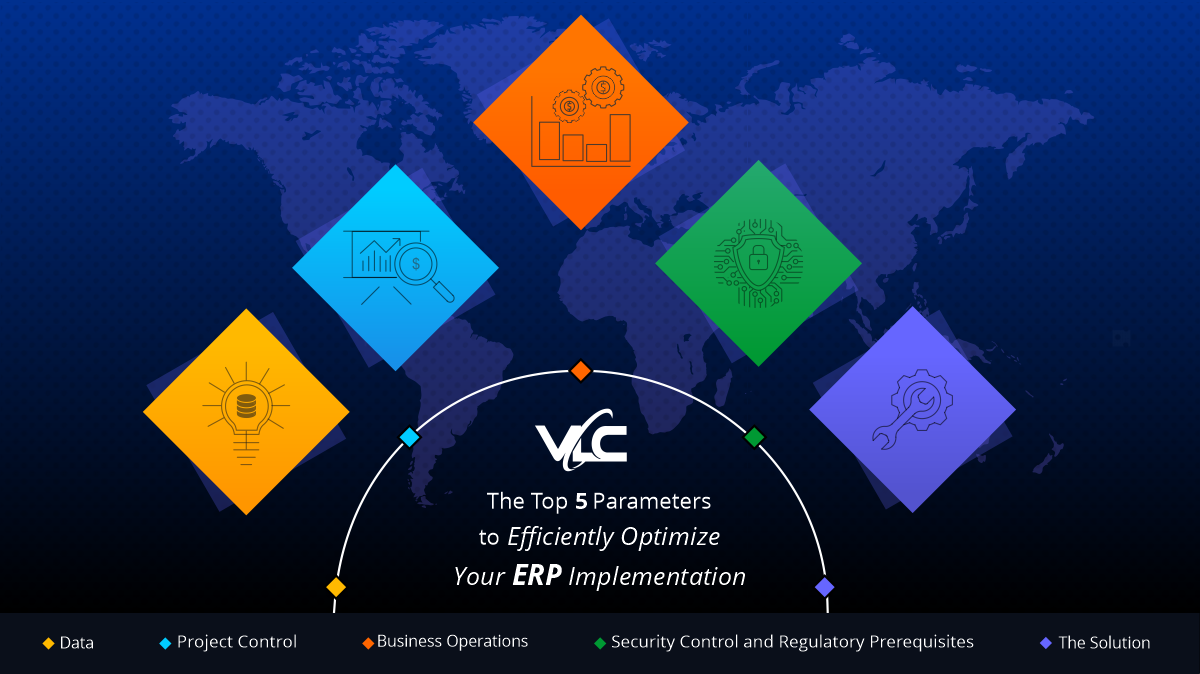The Top 5 Parameters to Efficiently Optimize Your ERP Implementation
Enterprise resource planning (ERP) is crucial for handling and sustaining business processes. Nevertheless, while such ERP platforms can be widely beneficial as they add substantial value, business divisions and departments must come together during implementation or system upgradation. This helps to bypass hazards that could detract from the return on investment, develop susceptibilities or drive regulatory crises. Various persistent threats throughout an ERP implementation make the process more expensive and build more waiting time as the project advances.
In this blog, VLC has determined the top 5 crucial ERP implementation pitfalls that correspond with the success elements of its implementation. As a company slowly addresses and cuts down these risks, the possibility for a flourishing ERP execution rises dramatically.
1) Data
If a business intends to ensure a proper ERP execution, it should utilize a satisfactorily designed data categorization strategy and relevant cleansing, organizing, and migration techniques. Possible data threats are unsuitable categorization of critical data, neglect in identifying data owners, negligence to relocate or validate data, adequate cleansing of unfitting data, and false data migration testing.
2) Project Control
A company has to focus on critical governance procedures, such as the funding and deadlines, and other pre-planning tasks such as resource allotments, solution and vendor preference, and deployment strategy. Project control and governance failure can cause an organization to gain less than expected from the ERP implementation. This has further got to do with communication problems, pauses, inadequate internal aid, and budget surpluses.
3) Business Operations
As one looks at the situation from an operational lens, it is imperative to have a post-go-live support system to handle evolving demands effectively. Also, at the same time, it is essential to regularly review and update healthy service level agreements with any third-party companies delivering these support services.
The company must also evaluate other business priorities that could impact the time and resource allocation of the project. With a dearth of productive processes, threats can surface in the form of post-going-live support not being able to manage operational demands and improper resource allocation, making it hard to maintain a healthy functional state during implementation. This also increases organizational vulnerabilities and can lead to the loss of vital data.
4) Security Controls and Regulatory Prerequisites
During the implementation of an ERP solution, a company must consider the relevant and applicable regulatory provisions such as the Defense Contract Audit Agency (DCAA), National Institute of Standards and Technology (NIST), and Payment Card Industry (PCI), ISO 9000, AS9100, etc. Along with the necessary guidelines on data privacy, etc., and how the ERP solution can align and aid in control automation. A robust ERP implementation unifies regulatory controls and adequate cybersecurity provisions without the classification of duties conflicts. Improper planning and research can cause ineptitude in fulfilling regulatory conditions after going live due to the lack of streamlined deployment of ERP abilities. So, this is an area that needs utmost carefulness.
5) The Solution
Finally, the ERP solution has to be explicitly developed to satisfy business needs while leaving scope for a future technology ecosystem that covers other interfaces and good infrastructure to fulfill the performance order. The organization must also sustain the awareness of new software features and execute compelling business consistency and disaster recovery procedures. Possible technology threats include vague interfaces and third-party systems distinction, unsatisfying system performance, unexpected functionality problems, and data blunders.
Furthermore, in case of cybersecurity difficulties, an ERP security vulnerability assessment can handle matters before going live. When a company does not have the required ERP experience or erudition, competent subject matter experts can assist in understanding the stakes and executing risk mitigation plans.
Conclusion
Ultimately, ERP project risk is quite probable and can transpire at any moment during the ERP execution life cycle, even before the project even begins. While these project threats may not always be fully avoided, they can still be determined, scrutinized, and mitigated before they cause marked problems.
For more information on this, or to get a robust ERP solution implemented or upgrades for your business with safety and sustenance in the long term, get in touch with us.
